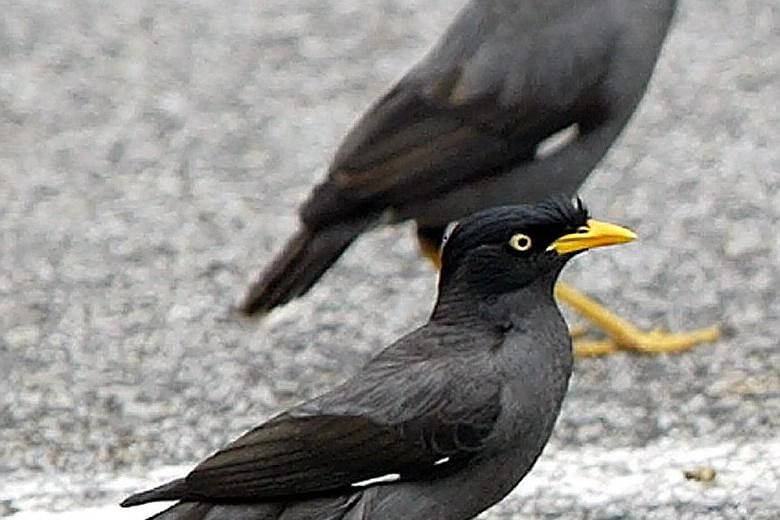The black and yellow-beaked Javan mynah may be a common sight here but it is a different story in Indonesia where they are from.
There, they have become a rare breed as a result of poaching.
There are fewer than 2,000 of them in Indonesia, with most in protected areas. In fact, the bird was recently listed as vulnerable by the International Union for Conservation of Nature (IUCN).
One way to save threatened species such as the Javan mynah could be to "harvest" members of the same species that have been introduced outside their native habitats, suggested a study by researchers in Hong Kong and Australia.
It was published last month in the Frontiers In Ecology And The Environment journal.
In total, the authors identified 49 globally threatened species - those listed by the IUCN as vulnerable, endangered or critically endangered - which have established populations outside their native habitats.
These include amphibians, reptiles, mammals and birds, as well as insects and plants, with "introduced" populations found on all continents except Antarctica.
"Across the planet, poachers have reached into the last remote habitats to harvest wildlife populations used for clothing, or are eaten, or kept as pets in faraway cities," said Dr Luke Gibson, from the University of Hong Kong, who led the study.
"In some cases, the traded organisms have escaped and are now thriving in their introduced habitats," he added.
One example is the Javan mynah, whose population in its home country has dwindled due to demand from the pet trade.
But these birds have thrived in Singapore and adjacent parts of Malaysia after many were released in both areas - both accidentally and deliberately. Today, more than 100,000 of them are found in Singapore alone - thousands of kilometres from Indonesia.
Mr Heru Cahyono, a bird conservationist based in Java, Indonesia, said the Javan mynahs are sold in markets in Indonesia from around US$6 (S$8.50) to US$15.
"Most of the buyers are local people and bird keepers. These birds are often purchased because they can sing and chirp and they are (used) to train other birds to sing along," he added.
Dr Gibson said he and Mr Yong Ding Li, a PhD student from the Australian National University, decided to work on the study in 2015 after hearing news of a seizure of an illegal shipment of yellow-crested cockatoos in Indonesia.
"They are a species which I see every day in Hong Kong, where I currently live and work.
"It was very surprising to me that such a conspicuous species thriving in the heart of downtown Hong Kong is critically endangered."

To tackle the problem, the researchers have proposed in the paper that the overseas Javan mynahs be "harvested" to offset demand from the pet trade. This means "to capture them in some kind of legally acceptable manner and use these captured individuals to supply the pet trade", said Mr Yong.
"It creates an alternative supply - and thus alleviates the threats faced by the native Javan mynah in its range in Java and Bali."
But wildlife consultant Subaraj Rajathurai said this could raise ethical concerns as it involves taking Javan mynahs back to their native habitat to be sold for the pet trade.
A better option could be captive breeding, where Javan mynahs are caught in Singapore and bred in a facility before they are sent to Indonesia. This, however, requires good planning and coordination by the governments of both countries.
Still, Mr Yong said he believes the idea they propose in the study is valid. While capturing Javan mynahs from their natural ranges in Java and Bali is illegal, the bird is not legally protected in Singapore.
"Harvesting" those in Singapore and Malaysia may lessen the need to poach wild Javan mynahs in national parks in Indonesia, he added, noting that "increased supply would also diminish the street value of a Javan mynah".
Incidentally,the Javan mynah is believed to have contributed to the decline of bird species in Singapore, such as the common mynah and oriental magpie robin.
According to the annual bird census by Nature Society (Singapore), the common mynah is now uncommon.
In 2014, there were just 13 of these birds, with the decline starting from 2003.
In 2003, the population of the Javan mynahs increased to 841. In 2008, it hit a high of 1,364.
Said Mr Yong: "Javan mynahs have increased dramatically in over 70 years to become the most numerous species in much of Singapore and peninsular Malaysia, and are directly competing with other native mynahs and garden birds."


